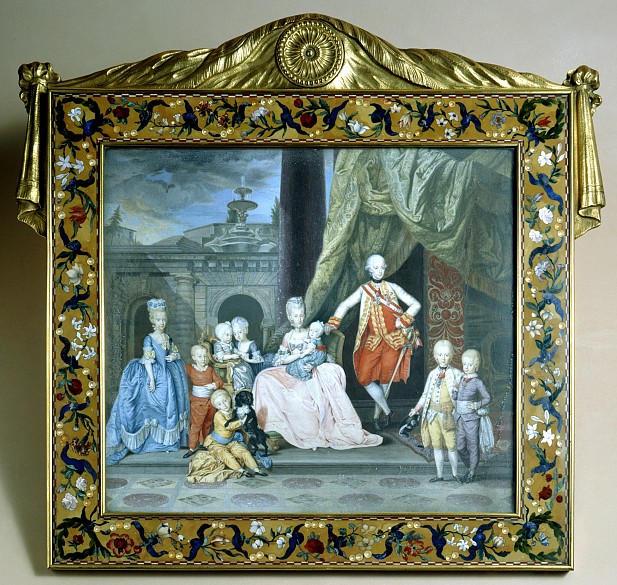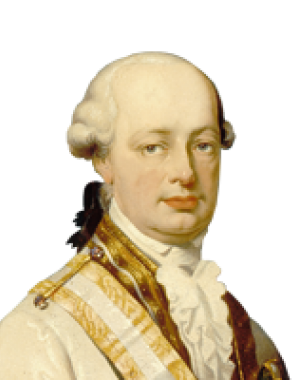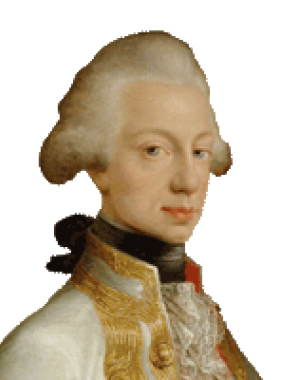Tuscany as a Habsburg secundogeniture
Thanks to Maria Theresa’s fecundity the Habsburgs were well provided with successors. Now opportunities had to be found to furnish the later-born sons of the ruling house with positions appropriate to their status.
The grand duchy of Tuscany came into the Habsburg sphere of influence in 1737 when Franz Stephan of Lorraine, Maria Theresa’s husband, was forced by the Great Powers to give up his ancestral lands, the Duchy of Lorraine, receiving the Grand Duchy of Tuscany in recompense. The Medici family that had made Florence a leading cultural centre during the Renaissance had come as it were to a genealogical impasse and had died out among the shattered remains of its former importance.
On the death of Franz Stephan in 1765 Tuscany became a secundogeniture of the House of Habsburg-Lorraine. The aim of this was to enable the second-born son of the emperor to rule over a sovereign state. Thus Tuscany became a satellite state of the Habsburg Monarchy. A further aim was to create a kind of dynastic gene pool. Should a Habsburg emperor die without issue there would be a collateral line which could continue on the imperial throne if necessary.
Anticipating this situation, Joseph II had summoned his nephew Franz, the eldest son of his brother, Grand Duke Leopold of Tuscany, to Vienna in order to groom him as his successor. But when Joseph died without issue in 1790 Franz was deemed to be too young and immature to succeed to imperial office, and so Joseph’s younger brother, Peter Leopold, Grand Duke of Tuscany, became emperor as Leopold II. However, he died suddenly in 1792, after ruling for only two years.
Leopold’s second-eldest son Ferdinand (1769–1824) assumed the regency in Florence at the age of only twenty-two. He was drawn into the maelstrom of events ensuing from the wars fought by Napoleon, who was bent on reshaping Europe at his own will. The Habsburgs were driven out of Tuscany in 1799 and were not able to return until 1814, when a new European order was established at the Congress of Vienna which aimed at eliminating the traces of the French Revolution and Napoleonic rule as far as possible.
However, this project was not entirely successful. The idea of the nation state and demands for civil liberties instead of feudal paramountcy remained alive among the populace. And in the rest of the Italian peninsula, which was divided up into small and medium-sized states ruled by various dynasties and the pope, liberal middle-class forces started to espouse the political ideal of a unified nation state.
Grand Duke Ferdinand continued the collateral Habsburg line in Tuscany. He married twice: his first marriage to Marie Louise of Naples and Sicily (1773–1802) from the House of Bourbon resulted in six children. Their wedding in Vienna in 1790 formed part of a great spectacle, as they were one of three couples tying the knot on the same day: three siblings from the House of Habsburg were marrying three siblings from the Neapolitan line of the Bourbon dynasty. Ferdinand’s elder brother Franz married the elder sister of Ferdinand’s bride, Maria Teresa, while the younger sister of the two Habsburg brothers Franz and Ferdinand, Maria Klementina, was married to the younger brother of the two Bourbon princesses, Francesco of Naples, who was just thirteen at the time. This dynastic mass-wedding stands out in posterity’s memory as the brides and bridegrooms were so very closely related. The parents of the bridal couples were also pairs of siblings from the Habsburg-Lorraine and Bourbon dynasties. Such an extreme case of inbreeding was a rarity, even in the world of the old European feudal nobility.
Ferdinand’s second marriage to Maria of Saxony (1795–1865) remained childless. The circumstances of this marriage were also unusual. Maria’s younger sister Maria Anna was already married to Ferdinand’s son from his first marriage, Grand Duke Leopold II, but no son had been born to the couple. In order to prevent the dynasty from dying out, the widowed 52-year-old Ferdinand married for a second time in 1821, his bride being the younger sister of his daughter-in-law and twenty-five years his junior. However, the union remained without issue, and Ferdinand died only three years later. His young wife survived him by 41 years.
Grand Duke Ferdinand III died on 16 June 1824 in Florence, where he is interred in the Lorraine chapel of the basilica of San Lorenzo, the burial place of the Tuscan rulers from the House of Habsburg-Lorraine.
Ferdinand’s successor on the Florentine throne, Leopold II (1797–1870), became ruler of Tuscany after the early death of his father in 1824. As monarch he implemented important economic reforms. Although his rule was in the main well-meaning, it was overshadowed by the currents of revolutionary Italian nationalism, which demanded an end to the profusion of small feudal states on the Apennine peninsula and the establishment of a modern nation state. After Leopold had agreed to the introduction of constitutional monarchy and the expansion of civil liberties following the revolutionary events of 1847/48, his pro-Austrian stance was rejected by the Tuscan government. Tuscany then joined the war of independence against Austrian rule in Northern Italy.
In an attempt to win back his throne, Leopold turned to his young kinsman on the Austrian throne, Emperor Franz Joseph, who put down the revolution in his empire with brutal measures and the utmost severity. Tuscany was duly occupied by Austrian troops. The Austrian military presence (until 1855) and the reactionary measures implemented by Leopold after 1848 such as the suspension of the constitution led to a drastic waning in popular support. At one time much loved as a ruler, Leopold became politically isolated at the unification of Italy in 1859 and was eventually driven out of Tuscany. Grand Duke Leopold and his family went into exile in Bohemia. Leopold died while visiting Rome on 29 January 1870. His body was interred in the imperial crypt of the Church of the Capuchin Friars in Vienna.
Leopold’s eldest son, Ferdinand IV (1835 –1908), was the last Habsburg to bear the title of Grand Duke of Tuscany. To avoid being deposed upon the unification of Italy his father had abdicated in favour of his son in 1859. But Ferdinand was unable to assume the regency in Tuscany. He bore the title of grand duke only pro forma, spending the rest of his life in exile in Salzburg. However, he only formally abdicated in 1870 at the urging of Emperor Franz Joseph, who was keen to improve relations with Italy.















